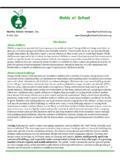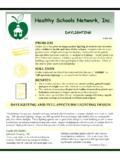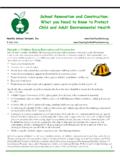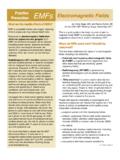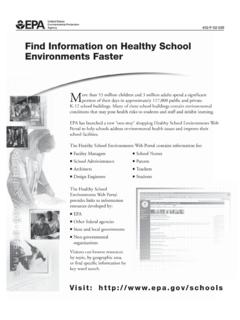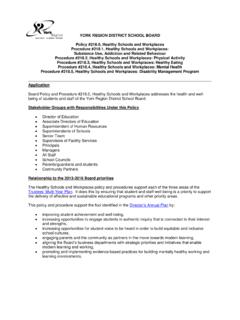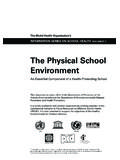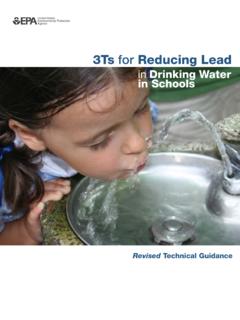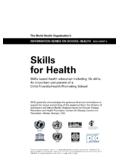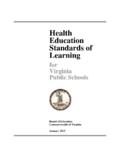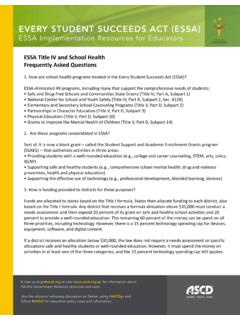Transcription of Guide To School Design - Healthy Schools Network
1 Guide To School Design Healthy + High Performance Schools Healthy Schools Network , Inc 2007. Healthy + Green = A+. A Healthy and high performance School uses a holistic Design process to promote the health and comfort of children and School employees, as well as conserve resources. Children may spend over eight hours a day at School with little, if any, legal protection from environmental hazards. Schools are generally not well-maintained;. asthma is a leading occupational disease of teachers and custodians that is, they get it on the job. There is a strong basis in science for designing Schools : 1) for Healthy indoor environments, and 2) for resource conservation. Together, Healthy + green designed facilities promote indoor air and environmental quality; thermal, visual, and acoustical comfort; and, energy, water, and material conservation.
2 Such facilities can also minimize construction/maintenance waste, fumes, debris and particulates that can harm School occupants and harm the environment. Design out common schoolhouse problems: Healthy + green = A+. Children Are Not Just Little Adults Schools Are Not Just Little Offices 54 million children attend Schools C hildren are especially vulnerable to environ- mental health hazards; moreover, Schools are four times as densely occupied as commercial everyday Schools are four times as densely occupied as commercial office space. office spaces and not well-maintained. Children Once a School is opened, children are required are at risk for exposure to School hazards to attend regardless of conditions or hazards.
3 Through breathing, touching, tasting the world There is no mandatory tracking or reporting of around them, and by encountering toxic materi- child illness or injury at School . als at home, in School , and in the community. Facility codes and maintenance are often ig- nored. Children eat, drink, and breathe more per No regulatory authority oversees children's pound of body weight than adults. environmental health problems that arise at Children are less able to identify and avoid School . hazards and have developing systems that Increased indoor air quality results in better may not detoxify poisons. health , decreased absenteeism and occurrence Children often play on the floor or ground, of asthma, respiratory infection, and fatigue.
4 And may accidentally be exposed to different Proper ventilation in Schools can lead to better sets of pollutants than adults, including concentration and health of the children and toxics in Schools . staff as well as decreased occurrence of head- aches and drowsiness. 1. Healthy and High Performance Schools Nationwide Federal Education Law No Child Left Behind Defines a Healthy and High Performance School (NCLB of 2001, Sec. 5581-86 ff): A School building in which the Design , construction, operation and maintenance: uses energy efficient and affordable practices and materials;. are cost effective;. enhance indoor air quality; and, protect and conserve water. US Environmental Protection Agency Design Tools for Schools High performance Design can have a positive effect on health and comfort and Design strategies such as daylighting have been shown to enhance student learning.
5 Good indoor air quality is essential for teacher and student health . Good Design also produces more comfortable environments with proper lighting, air temperature, humidity, and noise levels. This reduces distraction and creates environments where students and teachers can see clearly, hear accurately, and not feel too warm or too cold. Collaborative for High Performance Schools (CHPS). CHPS began in California with the US Green Building Council's LEED for New Construc tion Design criteria, were then adapted for School environments. CHPS has now been adapted for use by Los Angeles, San Francisco and many other districts in the state, as well as licensed for state use by Massachusetts, New York, New Hampshire, and generically for the New England States.
6 CHPS offers licensees a comprehensive Design protocol and an Operations and Maintenance Manual. See US Green Building Council LEED for Schools (v2) is recommended for its guidelines on the siting of Schools to ensure healthful sites and walkable communities. See Comment. High performance/green Schools are being built nationwide well within normal construction costs in California, New Jersey, Massachusetts, New York, North Carolina, Illinois, New Hampshire, Los Angeles, Mont- gomery County, MD, and elsewhere as a matter of policy: such as state or city laws (NYC, NH), executive orders (NJ, CAL), and School district policy (LAUSD, Montgomery County, MD). See Building Healthy , High Per- formance Schools : A review of Selected State and Local Initiatives, Tobie Bernstein, Environmental Law In- stitute, 2003 ( ).
7 2. The Robust Science of School Environments Green Schools : Attributes for health and Learning, National Research Council of the National Academy of Science, 2006. See . The expert panel found that there is a robust science behind Healthy indoor environments, and recommended that conventional green Schools also be designed for health benefits by addressing the following concerns: dryness, that is, keeping the site and building materials dry to help prevent mold and using mold-resistant building techniques; good indoor air quality through the proper ventilation and use of less-toxic interior materials; quietness, acoustical controls; well- maintained systems, that is, following construction with building commissioning to ensure that all systems work as specified.
8 And cleanliness through ensuring that the building is durable and easy to maintain (ex., accessible custodial closets, durable finishes and flooring). Science-Based Recommendations to Prevent or Reduce Potential Exposure to Biological, Chemical, and Physical Agents in Schools , Derek G. Shendell, et al., Journal of School health December 2004, Vol. 74, No. 10, a review of peer-reviewed publications and proceedings. A Summary of Scientific Findings on Adverse Effects on Indoor Environments on Student's health , Academic Performance and Attendance, 2004, US Department of Education, Office of the Under Secretary, Doc # 2004-06, Washington, DDDC, 2004., prepared for Congress pursuant to HHPS/NCLB.
9 Do Indoor Pollutants and Thermal Conditions In Schools Influence Student Performance? A Critical review of the Literature, Mendell, Heath, Indoor Air, Volume 15 Issue 1 Page 27 January 2005. Creating Safe Learning Zones: Invisible Threats, Visible Actions, Center for health , Environment and Justice, 2001 and updated, for sample policies and GIS maps on Schools built on or near Superfund and other hazardous site. See Do School Facilities Affect Academic Outcomes?, Mark Schneider, National Clearinghouse for Educational Facilities, 2002, at and ask search by title. New York State School Facilities and Student health , Achievement, and Attendance: A Data Analysis Report, Healthy Schools Network , Inc.
10 , 2005, comparing data on 100 School facilities and building-level educational data in two counties, and finding that environmental conditions of Schools related to achievement, attendance, and suspension rates. See Greening America's Schools : Costs and Benefits, Gregory Katz, Capital E, October 2006. Studies cited include those indicating that Healthy indoor environments can achieve an 87% reduction in flu, 67% reduction in Sick Building Syndrome, 46% reduction in upper respiratory problems, and a 39% reduction in asthma at School . Asthma is the leading cause of School absenteeism due to chronic illness and a leading occupational illness among teachers and custodians. See Add your notes here: 3.

